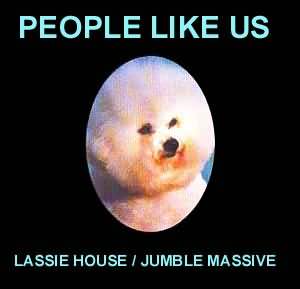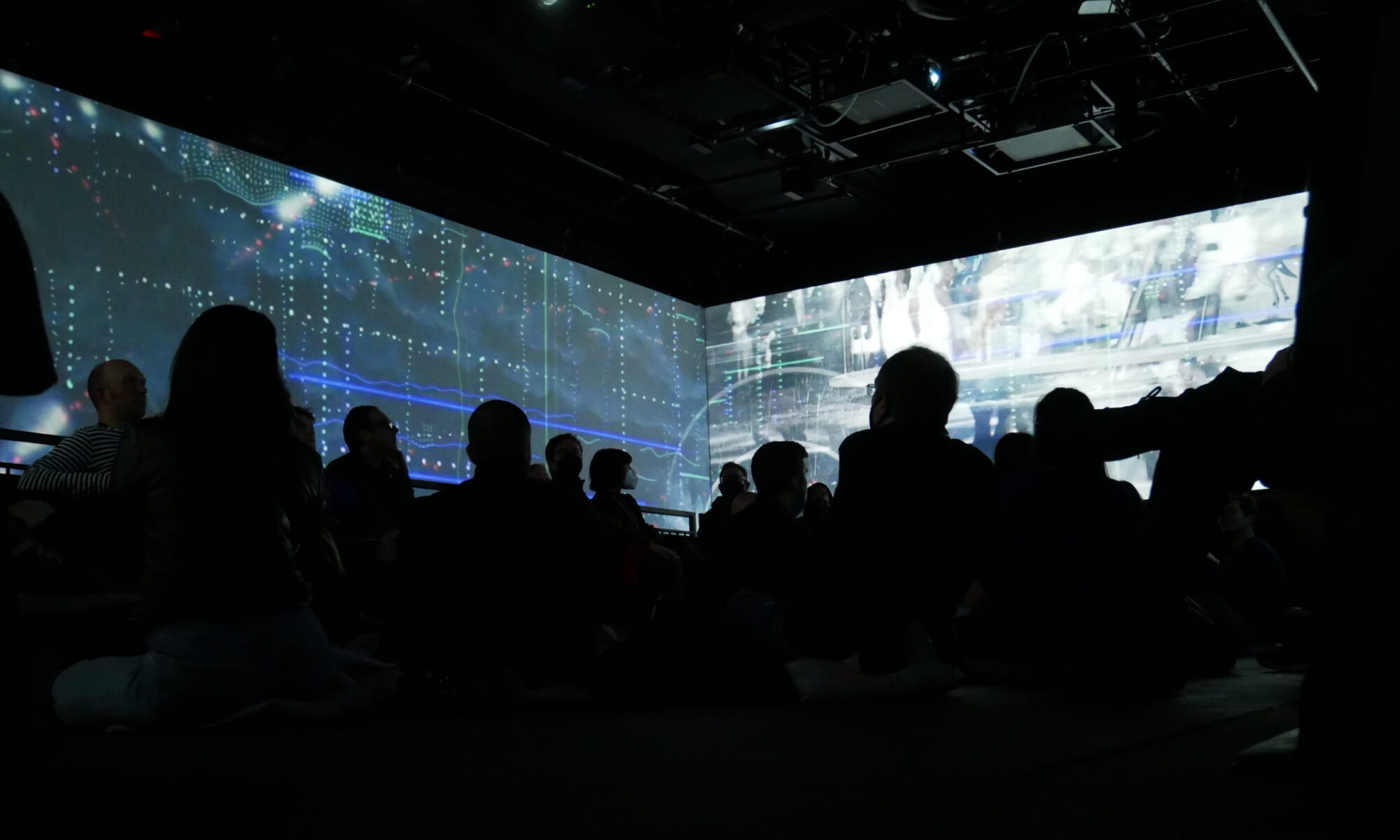Track made for a CD of Remixes of Kamahl (3″ compilation CD on Kryptonites) – 2002
01. Like
We Edit Life – short film
Download from UbuWeb

Download a larger version of this People Like Us photooverlay created from scenes from We Edit Life by clicking on the smaller image below.

People Like Us visit Prelinger Archives:

Recyclopaedia Britannica – Selected Works 1992-2002
10 Years of People Like Us (CD on Mess Media – MESS1) – 2002
SONGS OF LOVE AND HATE

The work of People Like Us rests gingerly between two dangerous positions: on the one hand, the risk of fashioning merely stylish pastiche out of borrowed finery for the sake of self-conscious kitschiness; on the other hand, the risk of making simplistic, heavy handedly “topical” audio-jokes at the expense of one’s raw material to a smug effect. If the lounge creeps uncritically snack on their sonic ingredients and coast on being “groovy”, the cads of pseudo-critique take cheap shots at straw men and call it subversion. Happily, Vicki Bennett has yet to fall down either precipice, but yodels down contentedly from her own Alpine audio-cottage. There, with loving care, she snips and tucks at the lycra jumpsuit until the fit is snug, places every plastic shrub on the Happy Valley Ranch just so, and throws another dance record on the bonfire. Undercutting her own utopian mirages with formal breakdowns and sneaky semantic pranks, Vicki Bennett is One Funny Lady, with a deadly sense of comic timing that puts her in my personal pantheon of edit intensive music makers: -Steinski and Mass Media, Hank Shocklee, Tod Dockstader, Teo Macero, the Hanatarash, John Oswald, Runzelstirn & Gurgelstock. Serving her birthday cake with a turd, her gags are always lined with a virulent creep factor. You get the feeling that the vacancy and pointlessness of empty speech is being lampooned and mourned in equal measure. In sticking to this balance of celebration and critique, People Like Us genuinely hates and loves People Like You. The least you can do is head up to the Happy Valley Ranch for a spell and have a listen.
Drew Daniel
01. Another Kind Of Humor intro
02. OB & Cha Cha
03. Guide To Broadcasting excerpt
04. Smash & Grab
05. The Sacred Erm
06. Sing With Melodious Inarticulate Sound…
07. A Crossed Line excerpt
08. Clippety Cart Horse
09. In The Panto
10. Ursula Fährt Ski
11. T424PLU excerpt
12. More Plunderblunders excerpt
13. Ski Heil excerpt
14. We Believe
15. T424PLU excerpt
16. Sound Escape excerpt
17. Sound Escape excerpt
18. Handjob
19. If Someone Touches You (with The Jet Black Hair People and Wobbly)
20. Music Of Your Own
21. Millenium Dome
22. My Son Jim
23. More Plunderblunders excerpt
24. Oompah Pumpah
25. I’m 89
26. Take A Walk
27. Morning Pedro
28. We Believe excerpt
29. Bran Mash & Crushed Beans
30. We’re Gonna Be Around
Mess Media through Soleilmoon website
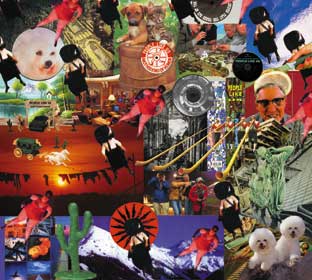
Mirrored here:
Kingdoms of Elgaland-Vargaland 1992-2002
This track was made for a compilation CD on Ash International – 2002
01. The National Humm
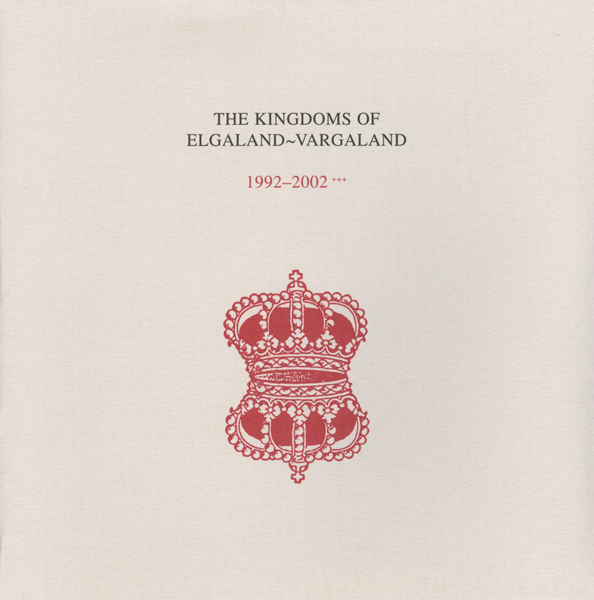
People Like Us & Friends play Ether, Southbank Centre – reviews
Here are some reviews on People Like Us and Friends performing at Ether Festival, Purcell Room, London. Participants for the evening were chosen by Vicki Bennett, based around each performance containing a lot of humour. The advertising made it seem like it was more to do with sampling but this was secondary to the humorous aspect when it came to choosing who would play.
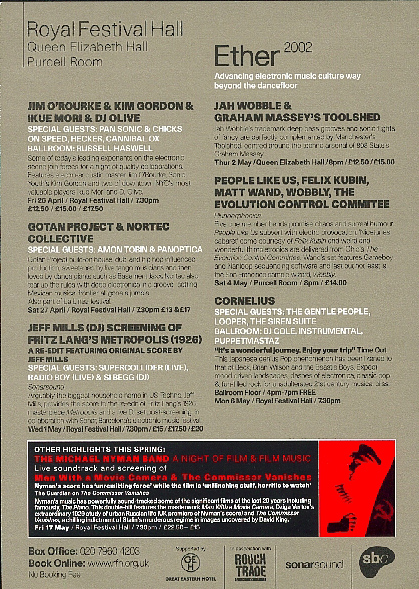
Despite the spike of recent interest in bootlegs, plunderphonia and other sonic ballyhoo, the small Purcell Room was only about half full on Ether’s night of digital disobedience, whose theme seemed decidedly undersold, since the cast included some real scoops for the UK stage. Phthalo/Tigerbeat6 magician Wobbly opened up with a heads down, no-nonsense digital blast zone, strafing and bombing the speakers with deftly processed and mulched samples, with no apparent rules of engagement. Evolution Control Committee’s Mark Gunderson gave a lecture presentation on the ECC’s activities like a Sesame Street presenter on coke’ his homemade thimble-trigger system providing visual stimulus as he refashioned food and drink ads, Public Enemy raps and TV voice-overs into (a)musing infobursts Felix Kubin’s demented, surrealist electro-ditties, accompanied by his charismatic self (Julian Clary meets Marc Bolan as extras in Liquid Sky) on kitsch Hammond organ, provide a deformed other take on the Miss Kittin style electrotainment that’s currently teetering on the mainstream brink. Matt Wand hunched in an easy chair, appropriately, to give a live rendition of some glitchy electronic ruckus on a pair of Gameboys running sequencing programs. But the evening belonged to Vicki Bennett aka People Like Us, whose ‘Recyclopaedia Britannica’ of sound/video mixes just gets better and better. She has locked into a personal editing style where the screen becomes a wide canvas for positioning sampled chunks of ‘where did she find that”‘ video, from weird American TV, government information films, vintage newsreel, patronising documentary and whitebread soap entertainment. Intelligently bringing out, through repetition, the hidden reverse of deceptively innocent bits of film, her tongue in cheek musical pastiches are at their most bitingly incisive as the soundtrack to the films. Don’t miss this great multimedia project as it hits its stride.
Rob Young, The Wire June 2002

Date: Sun, 05 May 2002 08:29:29 +0100
From: Bob Boster
Subject: [rumori] PLU, ECC, Wobbly (and pals) in London
Howdy,
Not enough time to do this show justice, but since I enjoyed the Tonic review so well I feel compelled to at least give it a brief overview.
Last night the Ether (non-dance electronic music) festival of the South Bank left/Royal Festival Hall hosted our stalwarts in the high late modernist style of the Purcell Room. About 200 people were there, possibly a few more. Certainly a crowd like this I’ve never seen at an event in ‘our’ musical community’s dedicated honor. The evening was headed ‘Plunderphonics’.
Wobbly opened. Jon’s set was a rolling, shifting affair with his trademark dense-pack assault as the primary material, sometimes integrating some rhythmic sections, and a couple times dropping away to more atmospheric sections. Travelling light (no keyboard) meant Jon didn’t get into one of his classic ‘song’ things, which was a shame for people who have never seen him before, but the set was so action packed, I’m sure no one else ever missed it.
Some Wild Why fragments here and there, but nothing like the full-on barrage. Some attempts at trainspotting worked for some audience members, but as Jon has gone more and more ‘Plexure-ish’ it doesn’t really give people the time to actually pin it down before he moves on. It’s more like the flavor comes into your mouth and then the next bite goes down before you can name that spice.
Guy next to us was a complete stranger and he was totally on top of everything at each moment, rolling back and forth with the joy of the chaotic stream and occasionally hooting or yelling when a real strong moment hit. It was a pleasure to take that in. Much of the crowd seemed really along for the ride on this somewhat difficult material, but there were the typical 3 or 4 who got overwhelmed after a few minutes and fled.
Next up ECC, my first live experience. Mark is actually talking and doing some schtick as part of the set, which was a good thing (as Jon was mute). His white coveralls, bright ‘mad scientist’ hair, and thimble controllers made a great visual image. I’m sure his deep voice and authoritative American accent worked for the crowd also. After a video opener, he did a somewhat thematic set of thimbletron stuff that worked for the crowd and really entertained.
One thing that worked for me personally was the fact that he sent his laptop graphics up to the video projection so people could see the waveforms (and sometimes make out the file names) of the bits being triggered by the thimble action. This worked to forward the technology into people’s minds without undercutting it by being too recognizable (assume that was custom stuff you wrote Mark…).
Anyway, the dramatic goofiness of the set, the completeness of the whole vision, and the entertaining aspect of the pieces really all worked well. I expected some sniggering at ‘American goofiness’ but didn’t overhear any.
Matt Wand played next. His placement in the set was perfect because he had a physical ‘wired’ quality that bound him to Mark, but what came out of it was totally abstract. Matt played looping sequences of pretty much pure tones from 2 Gameboys. The outcome was a slamming, largely rhythmic but non-dancey wash of this repetitive but always shifting crunchy noise. Nice and relatively minimal processing (although I couldn’t tell what part of the looping process was the gameboys and which was processing until afterwards).
Matt really pushed the show out into to new space by not having any ‘samples’ but the gameboy theme worked with the overview, and the set really rocked. Sort of like riding in a shopping cart down from the continental divide…it never stopped rolling, but the quality of the bumpiness changed every couple seconds.
We were then lucky enough to enter the wild and wonderful world of Felix Kubin. Felix puts an incredibly lovable thing together and it works on sheer innocence and the commitment of his dramatic vision. Arriving in full glam spaceman regalia, Felix came out and promptly announced that he’s not really a plunderphonic artist and proceeded to play a joyful set of SONGS, touching a style list from Trio to digital hardcore to Kraftwerk. To site himself somewhat in the style of the evening, he did a remix of a PLU cut, which worked.
Some songs had vocals. Much of the set had speech in the interstices, which was nice. There was a joyful feel about the whole thing, and somehow the kitsch gave it another link to the rest of the program, which was enough for it to be bound together successfully. His video had a great quality to it, also linking him to PLU’s set.
Someone needs to book Felix on a tour into SF and figure out how to properly promote it so all the possible vectors that would appreciate it show up…amazing live set.
Onto PLU, the headliner. Vicki did a unified set tied up with video. The meshing of the video elements in a style that totally fit into the aesthetic of Vicki’s musical work is a great thing to take in. I’m not sure that someone who comes to it without a background in the recorded work would have this experience with it, but that was really true for me. I saw her do some stuff with video in Chicago a couple years back, but it didn’t hold together like this (of course I also had a terrible site line in Chicago and this projection was glorious). Her aesthetic holds true for the music and the video in the same way, and makes a really powerful combination.
Another thing that worked for me about this set was that somehow really disparate themes and elements ended up holding together in some kind of shattered, surreal narrative. Many of us utilize this effect in audio, by returning to material repeatedly during a performance which seems to somehow bind things together. In this case, Vicki has done the same thing in video, and the quality ends up holding a very scattered set of pieces together into something with a completely coherent aspect. Really interesting, and entertaining. And the sense of following the ‘story’ added something new to the evening, keeping people plugged in even after 4 really strong sets before this one. The migration over to a video-centric presentation also gave the audience some new quality to hang onto.
Vicki was received triumphantly (all acts were, but I think the sense of Vicki as the ‘vision’ behind the line-up was apparent, and that added to her approval as well). Hats off to her, because this was a really significant context and a really great show to fit in it. Hopefully more of these things can be leveraged off this one (not least of which because I’d like a chance to grab an audience like that myself) and help to move London to the forefront of cultural capitals for this kind of music. Vicki’s really got the ball rolling and hopefully I can help push.
, Anyway, that’s all the data that comes to mind (after 5 hours sleep). Off to Paris and Munich (just missing NY and I’d have the M People in my head all weekend).
Any questions?
Your faithful correspondent,
Bob
Date: Tue, 07 May 2002 20:22:37 -0400
From: The Evolution Control Committee
Subject: [Rumori] UK Ether Festival
Just thought I’d jot down some reactions to the Ether festival at London’s South Bank complex (Royal Festival Hall & Purcell Room) and other related things…
First off, the most important portion of it for me (and I suspect most on this list) was the May 4 show at the Purcell Room, featuring Wobbly, The Evolution Control Committee, Matt Wand (of Hot Air and Stock, Hausen and Walkman), Felix Kubin, and People Like Us. 7.30 show, no intermission, 25 minutes for each artist. About 200-ish people thought it was worth paying 14 pounds admission for.
I have to admit my viewpoint was both great and terrible for this show, since I was in it and spent much of the time backstage… however, it does afford behind-the-scenes looks at things such as Felix Kubin sweeping the stage sans trousers.
WOBBLY. I’ve had the pleasure of playing a few shows with him of late, so I’ve seen what he does and have a basis for comparison of this show, and I’d say this was one of the best I’ve witnessed. Great transitions between segments (if you even noticed the transitions at all) of very chopped up stuff. Very thorough edits that only occasionally allow you to detect what the original source material might have been — no doubt left in the mind that it’s been thoroughly changed, altered, recycled, and improved. I only wish the audience could better have seen how Wobbly operates… probably most would assume he’s another laptop composer, except that his face isn’t glowing on-stage from the screen. Indeed, he uses no laptop at all but multiple Dr. Sample-style devices to put his stuff together live, each sample triggered lovingly by hand and tweaked in real time. It’s quite impressive when you can see his dexterity and how he does it, but unfortunately the audience misses out on that treat.
THE ECC. Well, obviously I had the worst view in the house on this one, since I was on-stage for it. I’ll just say that it felt like one of the smoother shows I’ve given and I got great feedback about it.
MATT WAND. Unfortunately I didn’t get to really see or hear his set, except a few brief moments. What little I could hear well sounded pretty interesting and I really wish I could’ve heard more and been out in the audience myself. Audience members I talked to later said that it was a bit plain to watch since the whole set was performed on Gameboys and effects pedals while Matt was seated left stage in a comfy chair. I was really interested in the Gameboy thing; I don’t know much about it, but earlier in the week I did another show where the opening act also performed with a Gameboy (and other instruments)…
FELIX KUBIN. Blew me clean away. Great performer with a great sense of humor that came through perfectly clear even though English is his second language (German is his first, since he’s from Hamburg). Now that I think about it, the night was really perfectly ordered, in that both Felix and ECC were very up-front and performance oriented, and Wobbly, Matt, and PLU were not, so the line-up alternated evenly between more and less “live” performances. Felix played organ/keyboard and synth with some backing tracks, doing songs that really weren’t sample-oriented or “plunderphonic” at all, but still quite enjoyable and memorable. The highlight of the set was a movie which he played the soundtrack for, bringing to mind the new wave sets of Liquid Sky or Dr. Caligari, as well as the cheap-set/high-creativity balance of Forbidden Zone. He packed his 25 minutes to the limit.
PEOPLE LIKE US. Like Wobbly, I’ve had the pleasure of seeing Vicki’s work a number of times over the past year, and each time it just astounds me more. I don’t tend to watch movies or videos more than once because I usually feel like I’ve absorbed all the important parts in one sitting, but the PLU videos always have me asking myself whether a certain bit was new this time or if I just didn’t catch it the first time I saw it. It’s phenomenal stuff, basically surrealist/plagiarist video seamlessly connected and laced together with a soundtrack improvised over the video’s “natural” audio track. Something of a dadaist, apolitical Emergency Broadcast Network or something. It’s a tired buzzword, but as far as a “multimedia” performance goes this is it — full video, great sound, holds your attention completely from start to finish. The great pity of it all is… there’s no way to see any of it outside of a live show! Save for one DVD compilation with one bit on it, I don’t think any of the video is available. But you might just want to view it as a live-only thing — you can’t see/experience live shows in your home, so just accept the video component as a live-only thing. Like Felix, a really dense 25 minutes, though I think I noticed that she cheated and went over. Good. 🙂
Overall, an impressive night on all accounts. Honestly, when the definitive guide to plagiarhythmic history is finally written, this should really be one for the books. I felt like everyone was in fine form and this was a rare and talented lineup. Kudos to all those that made this happen, especially Glenn Max, Jane Beese, Kirsten, Joana, and doubly especially Vicki for bringing us all together for this!
PLU, Irene Moon & The Evolution Control Committee – Sydney
Here’s an archive of a radio appearance on Brent Clough’s show from when we were all in Sydney.
01. People Like Us, Irene Moon and The ECC
Thanks to Brent Clough at ABC Radio National


Continue reading “PLU, Irene Moon & The Evolution Control Committee – Sydney”
Home-Roam-Play / Work-All-Day with Matmos
Here’s a split 12″ with Matmos
01. People Like Us – Home-Roam-Play
02. Matmos rmx PLU – Work-All-Day
Matmos website
Read a Wire review of People Like Us and Matmos concert at Sonar, 2001
Download at UbuWeb
Mirrored here:

PLU & Friends Volume 1
This was a CDr only release comprising of lots of live recordings made with friends of People Like Us – 2001
01. Track 1
02. Track 2
03. Track 3
04. Track 4
05. Track 5
06. Track 6
07. Track 7
08. Track 8
09. Track 9
10. Track 10
11. Track 11
12. Track 12
13. Track 13
14. Track 14
15. Track 15
16. Track 16
17. Track 17
18. Track 18
19. Track 19
20. Track 20
21. Track 21
22. Track 22
23. Track 23

Mirrored at the Free Music Archive:
Touch Sampler 00
From a compilation CD on Touch
01. KZSU14Sept99 – with The Jet Black Hair People and Wobbly
Touch website
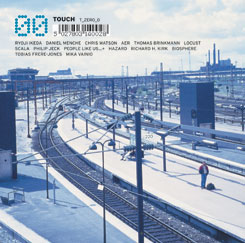
Two unreleased tracks from our archives
Here are a couple of tracks that People LIke Us made in 2001 but didn’t release. They are quite poor quality in their sample rate – put this down to the amazing napster, in the days when people were sharing files at a lower bit rate.
People Like Us – Raindrops
People Like Us – EdWardWoodWoodWould
Thermos Explorer
CD on Hot Air – AIRHEAD002 – 2000
01. Music Of Your Own
02. Take A Walk
03. I’m 89
04. Snippy
05. People Like You
06. Ipanmnmna
07. Millenium Dome
08. Uh Dear
09. Cream Crackers
10. Moronically Yours
11. Sugarbeat
12. Whistle Song
13. Caciocavallo
14. Pauline
15. Kitten
16. The Importance Of Mistakes
17. Sardines
18. Dolphy
19. Sugar And Splice
20. Nobody Does
21. ILY
22. People Like You
23. Serenade
Hot Air website
We still have a handful of CDs left – if you’d like one visit our shop. All prices include postage and packaging.
Mirrored here:
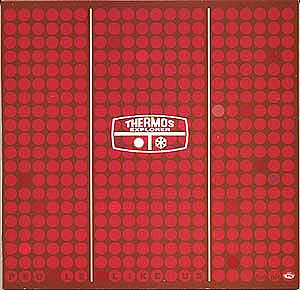
Lassie House/Jumble Massive
A joint CD on Cacioavallo – CAD9) – 2000
This was originally released as two separate EPs: “Lassie House” being a 10″ limited to 250 copies through Staalplaat in 1995; and “Jumble Massive” being an LP limited to 296 copies through Soleilmoon in 1996. Now, though, they are together and released, unlimited, through Caciocavallo. The material seems to fit together on one release nicely, with no major difference in sound between the two EPs. “Lassie House,” to some degree, has a more slapstick humor feel to it, though both conjure rememberence of 50’s UK gameshows and sitcoms, as well as children’s programs and circus tunes. Vicki Bennett is very clever with how she collages her clips and samples together, but I feel perhaps that this work lefts less on being “humourous,” per sae, and more and merely being nonsensical. The tracks are, as one EP’s title suggests, a massive jumble of cut up, repeated, morphed, and fucked sound clips from god-knows-where. A favourite hightlight is the last track, which acts as a mock self-help tape, helping “people like us” to cope with such things as sewing machines and anticipating bowel movements: you need only chant, “Come on, poo! Come on, poo! Poooo, coming! Poooo, coming!” These EPs were nicely worked for their time, but, to be honest, Vicki has since outdone herself with releases such as the Hate People Like Us remix album and her brilliant new (but not newest!) release, Thermos Explorer. Written by Daniel McKernan, November 2000, Brainwashed.com
01. T424PLU part 1
02. T424PLU part 2
03. 24T4PLU+ME part 1
04. 24T4PLU+ME part 2
01. A Crossed Line
02. Sound Escape part 1
03. Sound Escape part 2
04. Sound Escape part 3
05. Acoustic Mud
06. Bran Mash & Crushed Beans
There is an air of both humor and impending doom within the works of People Like Us. From her first release in 1991 People Like Us has created or contributed to more than 25 CDs and records as well as several collaborative releases and numerous compilation tracks. Lassie House/Jumble Massive is a mid-price reissue of two limited edition releases from Staalplaat and Soleilmoon. The name Jumble Massive describes the music perfectly. This album contains a hodge-podge mish-mash of spoken word snippets and accidental vocalization that have been skillfully edited together to make something inconceivably peculiar and wonder. There are some tracks which are more musical, but again, collage is the preferred method of creation. People Like Us have defined a new musical territory with an atmosphere primarily composed of nitrous oxide and adrenaline. Take a deep breath, but be ready to die laughing. “Lassie House” was released in the following year by Staalplaat as a 10″ picture disc, with a Bichon Frise dog printed on it in pink and blue. It featured two long hilarious spoken word pieces.
The tracks on this CD are available on this page but you can also buy the CD at our shop – all prices include postage and packaging.
